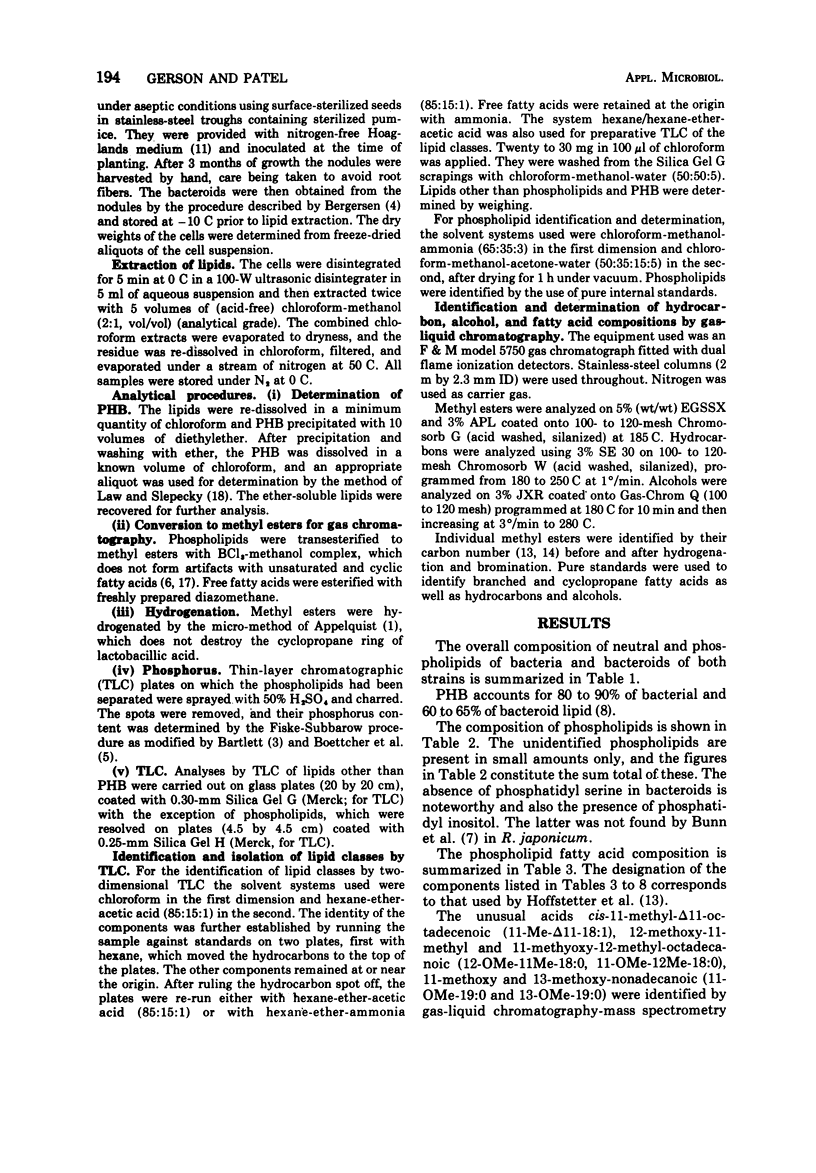Abstract
The neutral lipids and phospholipids of two strains of rhizobia in their free-living state and in symbiosis with a host plant are described. The principal lipid classes found were the polymer poly-β-hydroxybutyrate, phospholipids, free fatty acids, glycerides, methyl esters, aliphatic alcohols, and hydrocarbons. The lipids include unusual unsaturated methyl-branched and saturated methoxy-branched fatty acids. Most components were found to be common to both forms of both strains, although the proportions varied. A number of strain differences could be discerned.
Full text
PDF





Selected References
These references are in PubMed. This may not be the complete list of references from this article.
- Appelqvist L. A. A simple and convenient procedure for the hydrogenation of lipids on the micro- and nanomole scale. J Lipid Res. 1972 Jan;13(1):146–148. [PubMed] [Google Scholar]
- BARTLETT G. R. Phosphorus assay in column chromatography. J Biol Chem. 1959 Mar;234(3):466–468. [PubMed] [Google Scholar]
- Bergersen F. J. Some properties of nitrogen-fixing breis prepared from soybean root nodules. Biochim Biophys Acta. 1966 Dec 28;130(2):304–312. doi: 10.1016/0304-4165(66)90225-x. [DOI] [PubMed] [Google Scholar]
- Brian B. L., Gracy R. W., Scholes V. E. Gas chromatography of cyclopropane fatty acid methylesters prepared with methanolic boron trichloride and boron trifluoride. J Chromatogr. 1972 Mar 22;66(1):138–140. doi: 10.1016/s0021-9673(01)82938-1. [DOI] [PubMed] [Google Scholar]
- Bunn C. R., McNeill J. J., Elkan G. H. Effect of biotin on fatty acids and phospholipids of biotin-sensitive strains of Rhizobium japonicum. J Bacteriol. 1970 Apr;102(1):24–29. doi: 10.1128/jb.102.1.24-29.1970. [DOI] [PMC free article] [PubMed] [Google Scholar]
- DAWES E. A., RIBBONS D. W. SOME ASPECTS OF THE ENDOGENOUS METABOLISM OF BACTERIA. Bacteriol Rev. 1964 Jun;28:126–149. doi: 10.1128/br.28.2.126-149.1964. [DOI] [PMC free article] [PubMed] [Google Scholar]
- DHOPESHWARKAR G. A., MEAD J. F. Evidence for occurrence of methyl esters in body and blood lipids. Proc Soc Exp Biol Med. 1962 Feb;109:425–429. doi: 10.3181/00379727-109-27226. [DOI] [PubMed] [Google Scholar]
- Gerson T., Patel J. J., Nixon L. N. Some unusual fatty acids of Rhizobium. Lipids. 1975 Mar;10(3):134–139. doi: 10.1007/BF02534150. [DOI] [PubMed] [Google Scholar]
- Kaneda T. Fatty acids in the genus Bacillus. II. Similarity in the fatty acid compositions of Bacillus thuringiensis, Bacillus anthracis, and Bacillus cereus. J Bacteriol. 1968 Jun;95(6):2210–2216. doi: 10.1128/jb.95.6.2210-2216.1968. [DOI] [PMC free article] [PubMed] [Google Scholar]
- Kates M. Bacterial lipids. Adv Lipid Res. 1964;2:17–90. [PubMed] [Google Scholar]
- Klopfenstein W. E. On methylation of unsaturated acids using boron trihalide-methanol reagents. J Lipid Res. 1971 Nov;12(6):773–776. [PubMed] [Google Scholar]
- LAW J. H., SLEPECKY R. A. Assay of poly-beta-hydroxybutyric acid. J Bacteriol. 1961 Jul;82:33–36. doi: 10.1128/jb.82.1.33-36.1961. [DOI] [PMC free article] [PubMed] [Google Scholar]
- Leikola E., Nieminen E., Salomaa E. Occurrence of methyl esters in the pancreas. J Lipid Res. 1965 Oct;6(4):490–493. [PubMed] [Google Scholar]
- Shaw N. Lipid composition as a guide to the classification of bacteria. Adv Appl Microbiol. 1974;17(0):63–108. doi: 10.1016/s0065-2164(08)70555-0. [DOI] [PubMed] [Google Scholar]
- Wong P. P., Evans H. J. Poly-beta-hydroxybutyrate Utilization by Soybean (Glycine max Merr.) Nodules and Assessment of Its Role in Maintenance of Nitrogenase Activity. Plant Physiol. 1971 Jun;47(6):750–755. doi: 10.1104/pp.47.6.750. [DOI] [PMC free article] [PubMed] [Google Scholar]


